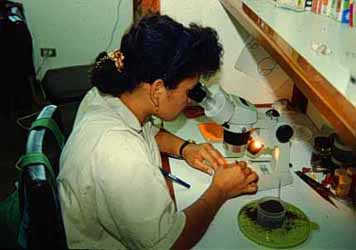
Research Program


The purpose of the Programa de Investigaciones is to stimulate, facilitate, take advantage of, and to actively participate in basic scientific investigation and apply it to the approximately 230,000 species (65% of the species in the country) and the interaction between the species, which make up the biodiversity that the ACG is trying to protect and conserve.
The ecological stations and the remaining administrative sectors of the ACG are located in strategic sites that allow the researchers access to the more than 22 terrestrial habitats that are found in the ACG. Each of these occupies many hectares and includes a combination of vegetation (including species compositions), wind exposure, soil type, and variable climate. Additionally 20 to 30 very different habitats can be found in smaller areas, such as: springs, intermittent lagoons, rainforest ravines, thermal springs and mudbaths, etc.
More than 50 research projects are carried out annually in different fields including insects, monkeys, bats, turtles, reforestation, population fragmentation, and birds. There are also many taxonomic investigations, as well as courses in biology, ecology, etc, that take place in the ACG, which are given both by national and international universities.
The program coordinates activities with the Instituto Nacional de Biodiversidad (INBio) for the National Inventory of Biodiversity. The parataxonomists (people from surrounding areas that are trained and specialize in the collection, preparation, mounting, and identification of biological specimens and compiling the associated information) and a marine biologist undertake the activities of the terrestrial and marine inventory, generating bases for the identification, classification, organization, and understanding of these species and the information associated with them. Also in coordination with INBio, different chemical studies are taking place, studying the smells and fragrances of samples of our biodiversity.
The Research Program also works in coordination with other programs in the ACG and other institutions, as well as national and international people, to establish better research facilities, and to participate directly in the research and the uses derived from biodiversity. Among these facilities are included; an up-to-date Geographical Information System (GIS), a Global Positioning System (GPS), a web of more than 30 automatic meteorological stations, equipment made for digitalizing images and managing data bases, the consolidation of "intellectual infrastructure of knowledge" in the form of people working in different fields, management and administration of biodiversity, etc.
The information generated by the different scientific processes will be placed in electronic format (INTERNET, data bases) and traditional format (guides and books), which will create a large base of knowledge and information that can be used or adapted to the needs of many users and that favor and promote the management and sustainable use of tropical biodiversity by the local, national, and international communities.
Information on the Marine and Coastal Resources in the ACG
|